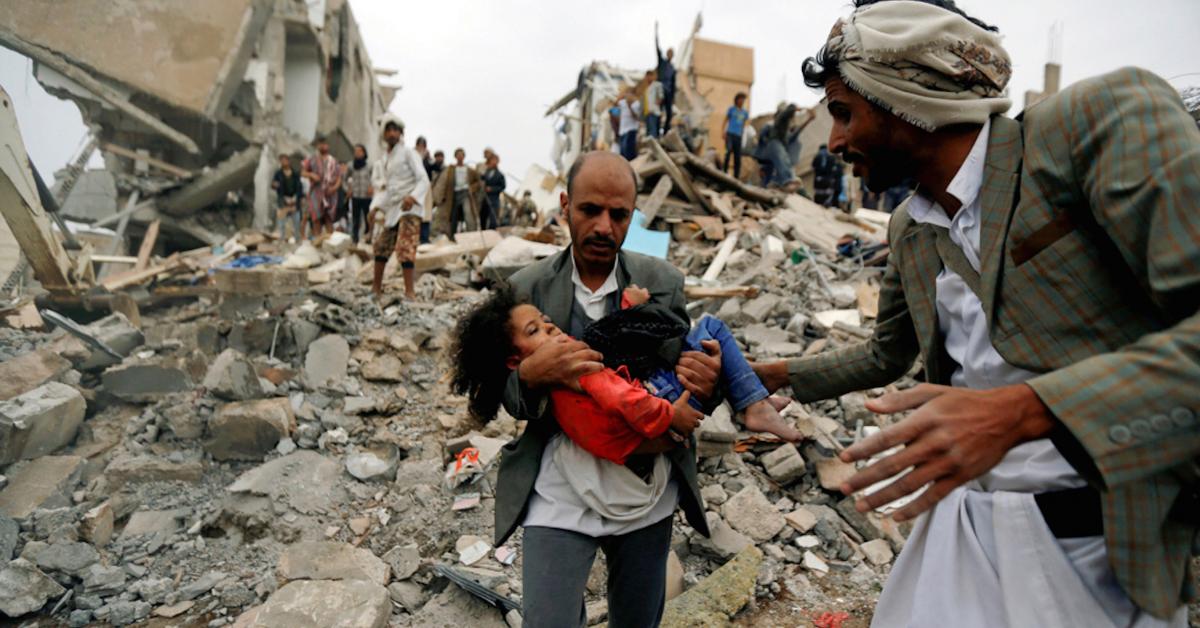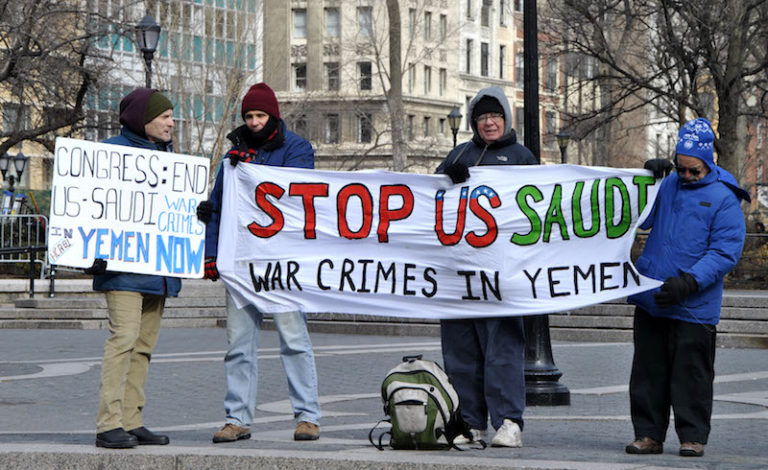
A child looks out at buildings damaged in airstrike.
Human Rights Groups Call on Pentagon to
Reinvestigate Civilian Deaths in Yemen
Nick Turse / The Intercept
(December 1, 2021) — “No military in the world works as hard as we do to avoid civilian casualties,” Pentagon spokesperson John Kirby said recently.
Experts say that isn’t true.
“There was a time I could have said that,” Larry Lewis, who spent a decade analyzing military operations for the US government under Presidents Barack Obama and Donald Trump, told The Intercept. “But that’s not what I’m seeing of late. Civilian protection is not prioritized. We’re not the best because we’re choosing not to be the best.”
The hard sell from the Pentagon comes in the wake of a New York Times investigation of a 2019 airstrike in Baghuz, Syria, that killed up to 64 noncombatants and was obscured through a multilayered coverup. It also follows intense media coverage of an August drone strike in Kabul, Afghanistan, that the Pentagon initially insisted was a “righteous strike” before admitting that it killed 10 civilians, seven of them children.
Revelations about these attacks have raised calls for increased scrutiny of US military strikes. On Tuesday, the Yemen-based group Mwatana for Human Rights and the Columbia Law School Human Rights Clinic asked Secretary of Defense Lloyd Austin to open new investigations of past US attacks in Yemen, apologize for the deaths of civilians whom the US has already acknowledged killing, and provide compensation to their families.
“The Department of Defense should do more to show it takes the prospect of accountability for civilian deaths and injuries with the seriousness it deserves,” wrote Radhya Al-Mutawakel, the chair of Mwatana, and Priyanka Motaparthy of Columbia in a letter sent to Austin and shared exclusively with The Intercept. “The recent New York Times report on civilian deaths in Baghuz, Syria indicates serious gaps in how the Department has ensured accountability. These events have raised serious concerns that there may be significant shortcomings in how the military responded to reports of civilian harm from Yemen, as well.”
A report by Mwatana released earlier this year examined 12 US attacks in Yemen, 10 of them so-called counterterrorism airstrikes, between January 2017 and January 2019. The authors found that at least 38 Yemeni civilians — 19 men, six women, and 13 children — were killed and seven others injured in the attacks.
Activists want Defense Secretary Lloyd Austin to open
new investigations of past airstrikes,
apologize for civilian deaths,
and compensate relatives.

A June Pentagon report on civilian casualties acknowledged one of those incidents, the death of a civilian in Al-Bayda, Yemen, on January 22, 2019. Mwatana’s investigation found that the attack killed Saleh Ahmed Mohamed Al Qaisi, a 67-year-old farmer who locals said had no terrorist affiliations. The US had previously acknowledged four to 12 civilian deaths in another incident chronicled by Mwatana, a raid by Navy SEALs on January 29, 2017, that was first exposed by The Intercept.
Both Mwatana and The Intercept reported a higher death toll. Regarding the remaining allegations, Central Command, which oversees US military operations in the Middle East, told Mwatana in an April 2021 letter: “USCENTCOM is confident that each airstrike hit its intended Al Qaeda targets and nothing else.”
But the Pentagon gives short shrift to investigations of civilian harm. Mwatana’s 156-page analysis of the 12 incidents was based on four years of investigations, often including site visits soon after attacks, by researchers who conducted nearly 70 interviews. It also drew on government documents, medical records, photographs, and videos.
In 2017, however, there were reportedly just two full-time staff members at CENTCOM responsible for assessing reports of civilian harm caused by US strikes in Yemen, Syria, and Iraq. A 2020 analysis of 228 US military investigations of civilian casualty incidents found that site inspections were carried out in just 16 percent of those investigations.
“The US military continues to refuse to conduct investigations of civilian harm where it can, and it never talks to victims and witnesses,” said Marc Garlasco, once the chief of high-value targeting at the Pentagon and now the military adviser for PAX, a Dutch civilian protection organization.
In their letter to Austin, Al-Mutawakel and Motaparthy pointed out that investigations by news outlets disproved initial reports that the August strike in Kabul killed only an Islamic State target. “Only after a subsequent review of these detailed facts from the ground did the Department of Defense acknowledge its error,” they wrote. “Similarly, we believe there is a need to open new investigations into the civilian harm reports we provided, based on Mwatana’s detailed investigations in Yemen.”
Exposés by journalists and NGOs have routinely been necessary to push the Department of Defense to investigate attacks and admit to killing civilians. For example, CENTCOM reported that between August 2014 and March 2017, at least 352 civilians were killed in US attacks in Iraq and Syria. But a 2017 investigation by journalists Azmat Khan and Anand Gopal of nearly 150 US-led coalition airstrikes targeting ISIS in Iraq found that 1 in 5 of the coalition strikes resulted in civilian death, a rate more than 31 times that acknowledged by the coalition.
A 2019 investigation by Amnesty International and Airwars, a U.K.-based airstrike monitoring group, revealed that while US-led forces took responsibility for 159 civilian deaths in Raqqa, Syria, more than 1,600 civilians were actually killed in air and artillery strikes. The US now acknowledges that 1,417 civilians were slain in US attacks in Iraq and Syria.
As the war against ISIS in Syria came to a close in March 2019, US aircraft dropped three bombs on a field in Baghuz, where women, children, and possibly a small number of ISIS fighters were sheltering, leading to a death toll that an Air Force lawyer in charge of determining the legality of strikes, Lt. Col. Dean W. Korsak, called “shockingly high.”
The military had determined in 2019 that at least four civilians were slain in the Baghuz strike, but those deaths did not appear in the Pentagon’s 2019, 2020, or 2021 civilian casualty reports to Congress. CENTCOM only admitted that civilians had been killed after the Times contacted the command with its findings. In an email Korsak shared with the Senate Armed Services Committee, a major with the Air Force Office of Special Investigations said that agents generally looked into civilian casualty reports only when there was a “potential for high media attention, concern with outcry from local community/government, concern sensitive images may get out.”
The circumstances surrounding the Baghuz attack offer additional reasons for skepticism of US claims about civilian casualties. While the death toll was “almost immediately apparent” and Korsak flagged it as a possible war crime, the Times reported, “at nearly every step, the military made moves that concealed the catastrophic strike. The death toll was downplayed. Reports were delayed, sanitized and classified. United States-led coalition forces bulldozed the blast site.” On Monday, Austin ordered a high-level inquiry into the strike and earlier investigations of it.
Lewis, who authored the 2013 report “Reducing and Mitigating Civilian Casualties: Enduring Lessons” for the Joint Chiefs of Staff, says it’s imperative for the Pentagon to create an independent review process for civilian harm. “It’s feasible because I’ve done it in Afghanistan,” he told The Intercept. “You need to know that someone is looking at your homework. If not, it’s easy to give it a half-effort — or worse. And this is what we saw in Iraq and Syria. We saw the same thing later in Afghanistan and in Somalia and Yemen too.”
“CENTCOM has never conceded a civilian death or injury from its actions in Yemen without either a journalist or NGO having already extensively reported on the case,” said Chris Woods, the director of Airwars. Its admissions only followed the reports of deaths by The Intercept and Mwatana and an Airwars investigation of a strike that the Pentagon later said wounded two civilians.
Over four years, the Trump administration conducted at least 181 attacks in Yemen, nearly the same number that Obama carried out during his eight years in office. Attacks under Trump resulted in up to 154 civilian deaths, according to Airwars. The Pentagon, however, claims that as few as five civilians were killed by the US during that four-year span.
There have been four alleged US airstrikes in Yemen during the Biden administration, including two earlier this month, according to data provided by Airwars to The Intercept. Central Command denies involvement. “CENTCOM conducted its last counterterror strike in Yemen on June 24, 2019,” the command told The Intercept by email. “CENTCOM has not conducted any new counterterror strikes in Yemen since.” The CIA did not respond prior to publication to questions about agency strikes in Yemen this year.
Like Al-Mutawakel and Motaparthy, Lewis says that the United States should reinvestigate civilian casualty allegations in Yemen. But he doesn’t think that the Pentagon should stop there. “We need an independent review for Afghanistan, Syria, Iraq, Somalia, Libya, and, yes, Yemen,” he told The Intercept.

PAX’s Garlasco went even further, calling for outside assessments of both targeting processes and civilian harm. “Only a complete and thorough review of US airstrikes by an independent body can provide the proper distance and recommendations to improve civilian protection,” he said.
Conducting reviews and reducing civilian casualties in US military operations will take more engaged leadership — on the part of the Pentagon or Congress — and dedicated funding, experts say. “One reason that this is such a mess is because this is not resourced,” said Lewis. “Civilian harm is a vast, complex, and challenging problem. DOD has $700 billion, but how much of it does it devote to civilian harm? Practically nothing.”
Despite acknowledging, for example, that it killed or injured 33 civilians in 2020 and having more than $3 million set aside for casualties resulting from US attacks, the Pentagon failed to make any “ex gratia” payments to survivors. Motaparthy noted that despite the Pentagon’s immense budget, the military routinely claims that it lacks the resources to quickly respond to civilian casualty reports.
“The US military should open new investigations into civilian harm we have reported and make a serious effort to understand the civilian impact of US operations,” said Mwatana’s Al-Mutawakel. “All civilians killed or harmed by the US military deserve acknowledgment, amends or reparations, and accountability for wrongs.”
Posted in accordance with Title 17, Section 107, US Code, for noncommercial, educational purposes.